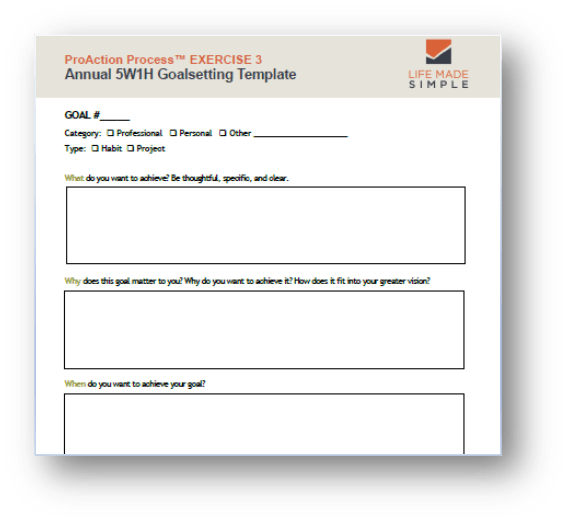
by Lori Vande Krol | Jan 9, 2025 | General Productivity, Goals and Priorities, Motivation, Planning, Team Productivity, Time Management
“What if a goal is unachievable?” This question came from an audience member during a recent goal-setting workshop I presented. I suspect she was referring to a goal assigned by her “higher-ups” at work – a goal she felt was unreasonable. Many of us, at some point, have likely felt similarly about personal or professional goals. My immediate response was, “But what if it is possible? What could happen if you actually reached that goal?” Before dismissing a goal as unattainable, it’s worth taking a step back and evaluating why it feels out of reach.
1. Know why the goal is important to achieve.
Without a good understanding of why a goal is important, it’s hard to drive passion and motivation towards achieving it. Ask yourself, “What is the ultimate purpose of this goal?” Understanding the “why” can help you stay focused and committed, even when the journey gets tough. This clarity often reveals where the goal aligns with larger organizational or personal values, making it easier to prioritize and tackle.
2. Review current and needed resources to achieve the goal.
Are there resource limitations that may hinder progress toward the goal? This evaluation should include people, time, money, tools, and technology. If the goal is truly unachievable using current resources, a case should be made for including needed resources in the plan for that goal. For example, if you lack the necessary expertise, consider seeking training or outsourcing. Similarly, if time constraints are an issue, reevaluate deadlines to ensure they are realistic and manageable. You might also look for ways to automate steps or work to create other efficiencies.
3. Get everyone in the boat and rowing the same direction.
Even if all of the people impacted by a goal know and understand the “why,” you may still have team members who disagree with the goal. A rowboat reaches the finish line only if all team members are rowing together in the same direction. Think how far and fast you can go if everyone is in sync and working together. To achieve this unity, foster open communication, address concerns, and ensure everyone feels heard and valued. When team members share a sense of ownership over the goal, they are more likely to contribute wholeheartedly.
4. Break the goal into smaller milestones.
Sometimes a goal feels unachievable because it seems overwhelming. Breaking it into smaller, actionable strategies and steps can make it more manageable. Each milestone achieved provides a sense of accomplishment and builds momentum toward the larger goal.
5. Evaluate potential obstacles and solutions.
Identify the barriers that make the goal seem out of reach. Are they external, like market conditions or budget constraints, or internal, like skill gaps or low morale? Once identified, brainstorm potential solutions or workarounds. This proactive approach transforms challenges into opportunities for innovation.
6. Be open to revisiting and redefining the goal.
While it’s essential to push boundaries, some goals might need to be adjusted to reflect reality. If, after thorough evaluation, a goal remains unattainable, consider redefining it. Adjusting the scope doesn’t mean failure; it’s about being strategic and focusing on what can realistically be accomplished while still striving for excellence.
Final Thoughts
Unachievable goals can feel daunting, but they also present opportunities for growth and innovation. By understanding the “why,” assessing resources, fostering team alignment, and adopting a strategic approach, you can turn seemingly impossible goals into achievable ones. Remember, the journey toward a goal often teaches us more than the destination itself. Even if you don’t fully achieve the goal, the progress made can set the stage for future success.
For a list of goalsetting resources, check out our prior blog: Goal Setting is Hard.

by Guest Blogger | Oct 3, 2023 | General Productivity, Team Productivity
In the fast-paced world of business, efficiency is the name of the game. With competition getting tougher by the day, it’s crucial to optimize workflows to ensure your business runs seamlessly. The secret to this lies in a blend of intelligent automation, effective project management, team collaboration, and customer insight. By strategically employing these elements, businesses can not only survive but thrive in their respective industries, setting the stage for sustainable growth and success.
In today’s post, we’ll dive into some proven methods for streamlining workflow for more efficiency and productivity.
Assess Your Current Workflow Processes
The first step to enhancing productivity is understanding your current workflow. Analyze each process, identify bottlenecks, and determine areas where improvements can be made. This comprehensive review should not be a one-time event but rather an ongoing practice, as continuous improvement is the key to maintaining optimal performance levels. To get started, consider working with Life Made Simple. We’ll perform a productivity audit to help determine areas for improvement and help you develop a plan to reach your goals.
Harness the Power of Project Management
In the realm of business operations, project management plays a pivotal role in maintaining streamlined workflow processes. It acts as the backbone that holds together various elements, ensuring tasks are completed within set timelines and budgets. Effective project management fosters improved communication, facilitates resource allocation, and promotes risk mitigation, ultimately driving productivity and efficiency.
Regularly Seek Team Feedback
Your team is on the frontline of your operations, and their feedback is invaluable. Encourage open communication and regularly seek their input on how processes can be improved. This will not only enhance workflows but also foster a culture of continuous improvement and shared responsibility.
Embrace Automation Tools
Automation is the future of business efficiency. Intelligent automation tools, including automation success platforms, can streamline tasks, reducing the chance of human error and freeing up your team’s time for more strategic work. These platforms are designed to manage and assist in automating a wide range of processes, from data entry to customer service. By leveraging an automation success platform, businesses can drive their productivity to new heights, demonstrating the transformative power of automation in the modern workplace.
Streamline the Onboarding Process
A well-structured onboarding process can significantly improve a new employee’s productivity. By providing clear instructions, training resources, and a detailed overview of their responsibilities, you can help them hit the ground running. Moreover, integrating them into your workflows from day one ensures they’re contributing to your business’s efficiency as soon as possible.
Implement a Customer Data Platform
Understanding your customers is vital to business success. A Customer Data Platform (CDP) can provide deep insights into customer behavior, helping you tailor your products, services, and marketing strategies accordingly. As such, it’s important to explore solutions for a customer data platform that best fits your business needs. The right CDP not only boosts sales but also enhances customer satisfaction, fostering loyalty and repeat business. By leveraging a well-suited CDP, you’re investing in a tool that can significantly influence your business’s growth trajectory.
Eliminate Throwaway Meetings
Meetings can be a significant drain on productivity if not managed correctly, not to mention they’re not cost effective. Consider whether each meeting is necessary and what can be achieved via email or collaborative software. By eliminating unnecessary meetings, you free up time for your team to focus on their core responsibilities, enhancing overall productivity.
In today’s competitive business landscape, optimizing workflows is no longer an option, it’s a necessity. By reviewing your processes, using a project management app, automating tasks, investing in a CDP, and eliminating unnecessary meetings, you can boost your business’s efficiency and effectiveness. Remember, the journey toward optimized workflows is a continuous one, requiring regular reviews and adjustments. But with the right approach and tools, you can turn this journey into a smooth ride toward success.
Written by Robert Schmitt of enneathinggoes.com.

by Lori Vande Krol | Jun 22, 2022 | General Productivity, Goals and Priorities, Motivation, Procrastination, Team Productivity, Time Management
I have a confession to make. Months went by this year before I finally took focused time to set my annual goals. While I help others to do this daily and understand the importance and benefit of annual goal setting, I was not able to complete the task for myself. I took some time to reflect on my reasons for procrastinating on this task, which helped me to work through and complete the process. Following are a few reasons you might find goal setting difficult as well as some tips and resources to make it simpler.
1. The goal, outcome, or supporting actions, are unclear.
Too many times, I have gotten hung up on taking action because the end result, or the full range of steps I need to take to get there, is not completely clear. I have to remind myself that taking some action is better than nothing at all. Often, as you start to take action the goal and end result becomes clearer.
In his article, The Goal is Not the Point, James Clear says: ” In other words, your goal becomes your compass, not your buried treasure. The goal is your direction, not your destination. The goal is a mission that you are on, a path that you follow. Whatever comes from that path—whatever treasure you happen to find along this journey—well, that’s just fine. It is the commitment to walking the path that matters.”
When the goal or destination is not clear, consider your goal a direction you are heading, and clarify the end result as you go.
2. Setting big goals is scary.
There are many fears that can hold us back from setting and achieving goals. “What if I fail?” or “What if I succeed? Can I handle it? What comes next?” Perhaps it is a fear of change or a fear of losing control that is holding you back. In times like this, you must ask yourself, “What happens if I don’t try?”
Are you willing to live with more of the same? The status quo? Or are you willing to accept some risks and potential challenges in order to grow and achieve more? What great things might happen, for yourself and others, if you succeed? Take time to evaluate your fears. Learn what is driving the fear and anxiety in order to push forward. You may find that you even enjoy the journey.
3. Goal setting has not been successful in the past.
Last fall I was presenting a course on procrastination. When discussing potential reasons for procrastination, I shared that we often fail to take action when the end goal is unclear. An attendee raised her hand and asked, “What is the point of setting goals? It never works.” I challenged her to think more deeply about her hesitation toward goalsetting. I asked if there was possibly something else holding her back. After the presentation, we talked further, and I learned that she had worked for large corporations most of her career. Those companies would go through the annual goalsetting process, but it would end there. Management would not follow through or follow up on the actions required to achieve those goals. Goals were not reviewed regularly. Employees were also unclear on how the company’s goals tied to their own vision and goals. The lack of a full system for goal setting and implementation caused it to fail, and employees no longer trusted the process.
If goal setting has not been successful for you in the past, reflect on the true reasons for this. What can be done differently to improve your chances of success? There are many tools and tips to support individual, team, and company goalsetting. The systems and processes used need to work for everyone involved. Below I share additional resources for successful goalsetting.
The potential reasons for avoiding the task of goal setting are not unlike the reasons for procrastinating any task. The first step is working to understand your unique reasons for avoidance and then to find the right tool and process for you and/or your team. There is no doubt you will grow and achieve more.
Additional Resources for Goal Setting
Goal Setting: A Scientific Guide to Setting and Achieving Goals by James Clear
Mastering Time Management: What To Do Before the To-Do List by Lori Vande Krol
Do You Have a Lot of Big Goals? Focus on What You Know and Love by Lori Vande Krol
The Superman: Goal Achieved by Lori Vande Krol
The ProAction Planner™: a system to turn your annual goals into action throughout the year
FREE DOWNLOAD: Use the button below to receive a free Annual Goal Setting Template

Annual 5W1H Goalsetting Template
FREE DOWNLOAD
It is not too late to set your annual goals for this year! If you’d like assistance with the goal-setting process, or in setting up systems for success, contact Lori at Life Made Simple or schedule your free 30-minute consultation. I’d love to help!

by Lori Vande Krol | Feb 24, 2021 | Goals and Priorities, Meetings, Team Productivity, Technology, Time Management
The availability and ease of Zoom and other virtual technology has been one of the bright sides of this past year. Without it, we wouldn’t be able to see our colleagues and friends while working safely at home, continuing education opportunities would be minimal, grandparents may not see their grandchildren whether it be a few miles or thousands of miles away, and those sick in the hospital may not be able to see their family. One of my favorite things about virtual calls during Covid is being able to see full faces instead of masked ones. But, according to a recent study done by Stanford University professor Jeremy Bailenson, founding director of the Stanford Virtual Human Interaction Lab, being in these virtual meetings throughout your day can lead to exhaustion and may even increase stress.
The Mercury News summarizes the findings and suggestions from Professor Bailenson’s study, which addresses Zoom Fatigue from a technical and physical perspective. Here I share three additional ways we can minimize this stress and exhaustion from the standpoint of planning and productivity.
Be Intentional About Holding a Virtual Meeting
If you are the one initiating the meeting, determine whether the meeting is absolutely necessary and if so, if virtual is the most appropriate format. Would a phone call or conference call work just as well? Or is the topic something that could be handled quickly over email or chat?
If you have been invited to a virtual meeting or webinar, determine whether it is necessary for you to attend. What value will you receive? What will you add to the meeting? Be intentional about your choices.
Block “Meeting Days” and Add Breaks
If you have been intentional about the meetings you attend and it is still necessary for you to have several meetings a week, try to hold meetings on the same day as much as possible. While you may still have some Zoom fatigue at the end of that day, the benefits of one or two meeting-free days are great. You will be able to focus for longer periods of time with fewer interruptions and without the nagging feeling in the back of your mind that you need to remember to log in at a certain time. You’ll also save a little time on those days you don’t have to be “Zoom ready.”
When you schedule several meetings on the same day, be sure to leave a little time between them – I suggest 30 minutes. This allows a cushion in case the meeting runs over and also gives you time to review your notes, clarify and schedule next actions, and reset before the next meeting. Be sure to leave a few minutes to get up, move around, and refill your water.
Meeting Standards Don’t Change in a Virtual Setting
Standards and guidelines for a video meeting should be the same as an in-person meeting (except that sweatpants or leggings and a quiet pet in the background is perfectly acceptable). Someone should be responsible for the agenda, make sure that everyone has the materials they need ahead of time, and assign a leader to keep the meeting on track. Also, don’t end the meeting without full clarity regarding next actions and who is responsible. Learn the 5 key steps to an effective meeting.
I also recommend allowing a few minutes at the beginning of the meeting to check in with everyone. It’s been a tough year, and we could all use a little reassurance, support, and reminder that we’re all in this together.

by Lori Vande Krol | Feb 17, 2020 | Task and Project Management, Team Productivity, Technology
Unless you completely avoid politics and social media, you have no doubt heard about the “caucus chaos” that recently occurred right outside my door in Iowa. Much of the media has blamed the chaos on a new smartphone app the Iowa Democratic Party implemented to help get results more quickly. Because I have a large interest in the successful selection and implementation of technology, I thought I’d dig into it a bit further. What happened in Iowa is just one very publicized example of what happens daily in companies and organizations that do not take the time to properly analyze their vision and needs when choosing a new technology tool, or to carefully plan for a successful implementation of the chosen system. How could this have been avoided?
What Went Wrong with the Iowa Caucus?
It is true that much of the cause for reporting delays and questions about count accuracy was due to a “coding error” in the Shadow smartphone application that was used by the Iowa Democratic Party (IDP) to report caucus voting results. The error resulted in only partial results being reported. But if you look just a little deeper, there were more underlying issues that can’t be blamed solely on the creator of the application.
Following are additional factors leading to the issues with the Iowa Caucus:
- State campaign finance records show the IDP paid Shadow, the tech company that created the app used in Iowa, more than $60,000 for “website development” towards the end of 2019. Shadow (or what I’ve also seen called the Iowa Reporter App) was a new app, reported to be just 5 months old, and created specifically for reporting of caucus results. This is not enough time to have been developed and fully tested before being rolled out for such a large and public endeavor.
- Once the IDP had the app, there was not enough time for users to learn and test it themselves. In fact, some users weren’t even able to get past the log-in screen.
- This year, a new set of reporting requirements was put in place by the Democratic National Committee. Historically, precincts would only announce the outcome in terms of state delegate equivalents (S.D.E.s). In 2020, precincts were required to report three numbers per candidate: (1) raw vote totals, (the initial alignment), (2) the totals after the shifts of participants from non-viable candidates (the second alignment) and (3) the estimated delegate count for each candidate. While this may be confusing for those not involved with caucus procedure, it isn’t difficult to reason that this increase in requirements, along with the use of a new application, and short time frame for development, training and testing, was the start of “the perfect storm.”
- In addition to the Shadow app, it was reported that there were training issues with other programs needed for efficient reporting of results, including Google Sheets, and problems with 2-factor authorization needed to access those programs.
- The back-up process for reporting results when the app did not work was to call headquarters and manually report results (which is the way it had been done in past years). But, there were not enough lines and/or people to answer these calls and volunteers were left waiting for hours. It was quite obvious the back-up plan hadn’t been fully thought through.
It is my guess that there were more issues involved in the selection and implementation of caucus reporting systems and processes this year. Iowa Democratic Party Chairman, Troy Price, has called for an independent forensic review of the decisions and processes (or lack of processes) that led to the failure. I look forward to learning more from that review.
2020 Iowa Caucus Consequences
What we do know is that there has been some pretty large consequences of the lack of proper analysis, testing, and implementation.
- Chairman Price has resigned as chair of the party after 2.5 years of service, effective as soon as a replacement is elected.
- The Nevada Democratic Party, who had planned to use Shadow, has now dropped the vendor.
- The Democratic National Committee Chair, Tom Perez, along with the Bernie Sanders campaign, have asked for a “recanvassing” check of votes.
- Thousands of extra volunteer and paid hours were needed to report the initial results and will be needed to assist with the recanvassing as well as the independent forensic review.
- The negative PR for the Iowa Democratic Party and the state of Iowa will likely result in Iowa losing its status as the first caucus state in the country, with a large impact to hotels, restaurants and other local vendors that benefited from the event. It is not unreasonable to assume this misstep has costed the IDP and the State of Iowa hundreds of thousands of dollars.
How the Caucus Chaos Could Have Been Prevented

The chaos that occurred in Iowa could have been fairly easily prevented. Following are the key components of successful technology assessment and implementation, and what may have been missing from the Iowa Caucus process:
Understand Your Need and Create a Vision for Success
What is driving the desire or need for the new system or tool? Are you solving an issue, creating efficiencies, or enhancing a process in another way? What will success look like? What will you be able to do that you cannot do now?
What was missing? While we won’t know for sure until after the independent review, I have to wonder if the IDP did what I see many other companies do…they go for the newest shiny object without truly analyzing the need and how the tool might fulfill it. Was it necessary to change the current system for caucus counting and reporting? What was the specific issue that needed to be addressed? If there was a challenge in the current process, or the IDP wanted to save time and create efficiencies by using an automated app, was a vision defined? How did they see a new tool working and what would success look like? They could then choose a tool to best fit that vision for success. Perhaps the IDP did spend some time on this component and was clear in their need and vision but faltered in a later step.
Implement a Needs Analysis
A formal Needs Analysis takes the component above – understanding need and vision – several steps further in that it provides a process for decision makers to gather information needed to select the optimal technology. The Needs Analysis will address:
- resources available and new resources needed to implement and maintain the tool, including human and financial resources, and timeline;
- any obstacles that could get in the way of implementation or maintenance of the tools;
- level of comfort with technology, leading to a better understanding of training needs;
- features needed, which can be gathered in a format such as “must have”, “nice to have”, and “not needed.”
What was missing? Did the IDP take the time to evaluate all of these steps prior to asking Shadow to develop the app for them? They may have been clear on their budget and the needed features, but it is clear that not enough time was spent discussing obstacles that could prevent effective implementation (such as the app not working when it is needed most!), training needs due to many users not having a high level of comfort with technology, and the impact of an unreasonable timeline for development, testing, and training. This could have all been addressed with an appropriate Needs Analysis.
Match the Need with the Technology
Once the Needs Analysis has been completed, it becomes much easier to match the appropriate technology tool with the need. There are many great resources to find and evaluate applications but what is most important is to find the tool that best matches the results of the Needs Analysis and to evaluate the strength, security, and longevity of the application’s creator and/or owner.
What was missing? Without the appropriate Needs Analysis, it was impossible for the IDP to know whether they were choosing the most optimal system. Based on a February 4, 2020 article from The Atlantic, there is evidence that this was a situation in which leaders in the IDP knew some of the leaders in Shadow’s company and that appeared to be enough to move forward with their application.
Develop the Project Plan
Once the optimal technology is chosen, it is time to develop a plan for successful implementation. There is too much involved with project planning to cover here (refer to Get Unstuck With a Simple Project Plan for project planning tips), but the importance of creating and following a technology implementation plan cannot be stressed enough.
What was missing? What wasn’t missing? I believe that due to the tight time frame involved, the IDP had no time to develop or carry out a successful project plan. Just a few of the pieces missing were: (1) time for testing the application, (2) training of all users, and (3) creation of backup plans for multiple situations.
Take a Holistic View of Technology
A holistic view of technology means looking at all of the systems currently used by an organization and determining how new technology will coordinate and compliment those systems. This is important for an efficient implementation of the new technology as well as continued effective use and maintenance.
What was missing? While I am not aware of all of the systems utilized by the IDP, one main obstacle that was not addressed was how to coordinate the use of the new application with those precincts that desired or needed to continue to use the old, manual method of reporting. It has been reported that the IDP assumed all volunteers would download the app with no issues, even though some did not receive instructions to do so until 2 days before the caucus. Staffing and technology needed to take the manual calls was not sufficient. Additionally, there was the issue with 2-factor authorization that was discussed earlier. Cell phones were not allowed in counting rooms, but 2-factor authorization within the technology required volunteers to have their cell phones to receive the security code. Understanding how the technology would need to coordinate with the use of cell phones was vital here.
What Have We Learned from the Iowa Caucus Chaos?
While the Iowa Caucus gaffe was certainly unfortunate and impactful, how many can say they have never been involved with an organization that has not made a similar mistake – rushing through decisions, not completing a thorough needs analysis, or not developing and following a project plan? In my work as a productivity consultant, I often find during new client discovery sessions that some of their productivity challenges are caused by the mistakes made in technology selection and/or implementation. Organizations ranging from Fortune 500 corporations to very small businesses struggle every day with the results of poor planning and decision-making resulting in thousands of hours and millions of dollars lost and frustrated management and employees. Additional time and money are then spent to clean up the mess and redo the process the right way.
Hopefully some good can come from the Iowa Democratic Party’s mistake, that is a larger awareness of the importance of following the steps for successful technology implementation. While it will take more time and effort upfront, we have learned that the consequences of not doing so can be much greater.

by Lori Vande Krol | Sep 24, 2019 | Goals and Priorities, Procrastination, Task and Project Management, Team Productivity, Time Management
Have you ever read a book that changed your life? At the recommendation of several friends in the business world, I recently completed Building a Story Brand by Donald Miller. Donald promises that after reading his book you will be able to “use the 7 elements of great storytelling to grow your business.” Before reading Building a Story Brand, I had never been excited about marketing. It does not come naturally to me, I am not good at it, and it is not fun for me….at least these have been my excuses for when I don’t put in the time and effort needed as a business owner.
The content of Building a Story Brand really struck a chord with me and provided me with a way to view “marketing” like I haven’t before, but this isn’t a book review. The truly eye-opening result of the book was that I was reminded of the importance of two things for any successful endeavor:
- A clear vision that resonates and
- a simple project plan.
While I had hired marketing experts in the past to assist me with specific pieces of my branding and marketing, I did not have an overriding plan that resonated with me. This book provided that for me. For someone who helps clients clarify their goals and develop customized productivity plans for a living, I’m embarrassed to admit it took this long to realize what I was missing!
Building a Plan for Productivity
What have you been procrastinating, or avoiding, in work or life? What projects have been slow-moving or “stuck” within your office or business? What reasons have you, or your team, used for not taking action? Could it be that you also need a clear, concise plan that resonates? Project plans not only provide the step-by-step tasks needed to reach your goals but can also help you “get unstuck” and motivate you and your team. (For more tips on tackling procrastination, check out “Reduce Procrastination with 3 Powerful Steps”.)
Parts of a Successful Project Plan
When creating or revising a plan, be sure to include the following important aspects:
Create a Vision for Success
What will the final result look like? How will success feel? What will you be able to do that you can’t do now? What drives you and your team towards this vision?
Determine Your Goals and Actions
Define the high-level goals that are needed to reach your end vision and put specific action steps behind them. Don’t make it too difficult at first – you can fine tune as you go.
Evaluate Your Resources
What human, technology, budgetary and other resources are needed to reach your goals? What do you have now and what additional resources are needed?
Schedule Your Actions
Once you have your actions and resources defined, you can determine a schedule for completion. Consider choosing an end-date and working backwards. Or, choose intermediate deadlines for the high-level goals and then schedule your action steps to meet those dates.
Celebrate and Maintain Your Success
Celebration is a great bridge between project completion and maintenance. You will also need to determine how you will maintain your success.
Consider Your Risks and Obstacles
For most projects or goals, it’s also important to consider and discuss any risks and obstacles you might encounter along the way and how they’ll be addressed.
Just Get Started
 The most important thing is to get started, or “just do it” as Nike® would say. If you don’t have a complete, detailed vision or if you aren’t yet sure of the resources needed for each goal or task, that’s okay. You can start with a good framework and add to it – or even change direction if needed – as you go. Start small to gain momentum. Don’t waste another day before tackling that project, writing your book, or getting healthier. Whatever your end goal, just jot down your vision, goals and tasks and take action!
The most important thing is to get started, or “just do it” as Nike® would say. If you don’t have a complete, detailed vision or if you aren’t yet sure of the resources needed for each goal or task, that’s okay. You can start with a good framework and add to it – or even change direction if needed – as you go. Start small to gain momentum. Don’t waste another day before tackling that project, writing your book, or getting healthier. Whatever your end goal, just jot down your vision, goals and tasks and take action!
P.S. If plan development isn’t your thing, I’d love to help. I’ll listen to your needs, help you fine-tune your vision and goals, and document the action steps needed to reach your vision. I can also remain by your side to provide support and accountability as you walk through your customized plan. Schedule your free 30 minute productivity assessment to see if productivity coaching is right for you.









 The most important thing is to get started, or “just do it” as Nike® would say. If you don’t have a complete, detailed vision or if you aren’t yet sure of the resources needed for each goal or task, that’s okay. You can start with a good framework and add to it – or even change direction if needed – as you go.
The most important thing is to get started, or “just do it” as Nike® would say. If you don’t have a complete, detailed vision or if you aren’t yet sure of the resources needed for each goal or task, that’s okay. You can start with a good framework and add to it – or even change direction if needed – as you go.
Recent Comments